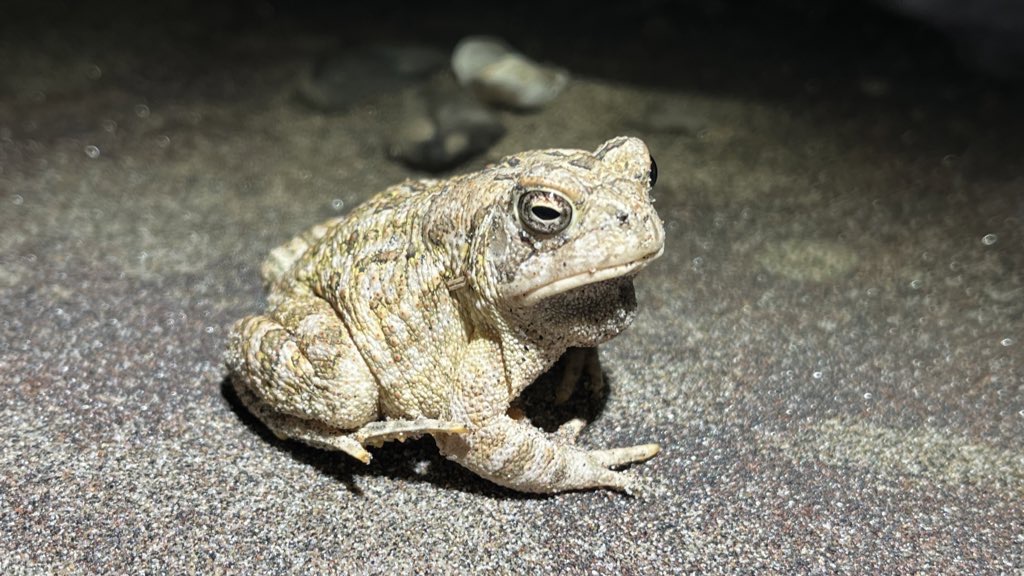
Last spring, researchers in Long Point, Ontario, noted a significant development. After years of population decline, the endangered Fowler’s toads in the area were finally starting to reproduce on their own.
For David Green, it was the culmination of more than 30 years of research. Since 1988, Green, a professor in the Redpath Museum and the Department of Biology, has divided his time between Montreal and Long Point, on the northern shore of Lake Erie, where he studies the Fowler’s toads that make their home on the area’s sandy peninsula. “We were on the ground studying this population in depth for decades, and at long last, we know how to keep them from dying out because we understand what they need to survive,” said Green. “For all this work, we finally figured it out.”
A
s ectotherms – meaning they don’t generate their own heat – Fowler’s toads control their body temperature by maneuvering around their environment as ambient temperatures fluctuate. In the summer, these “sand-dune specialists” spend their days hiding beneath the dunes, emerging at night to forage for insects. In winter, they escape the coldest temperatures by burrowing deep in the dunes’ ancient sands, nearly frozen and motionless below the frost line, before resurfacing in springtime as temperatures rise.
For decades, Green, his students, and a small army of volunteers monitored the species’ population at Long Point. Fowler’s toads bear a distinctive spotted pattern on their backs, and as Green tracked the population across years, he discovered that each toad’s pattern was unique and stable – it stayed the same throughout the toad’s lifespan. This meant Green could use the pattern to identify and track individual toads, in the same way a fingerprint might be used to identify a human. “Our identification and cataloging process makes for a very powerful approach,” Green said. “It enables us to not only very accurately monitor the species’ population trajectory, but also ask a host of different fundamental ecological systems questions.”
Declining amphibian populations

Starting in 2004, he and his research team began to notice a steady drop in the population. “People think of frogs as being delicate, but they outlived the dinosaurs and they will outlive us,” said Green. “They are as tough as bullets, so when such a resilient animal is in decline, you really start to worry.”
It wasn’t just the Fowler’s toad. For decades, researchers around the world have reported a steady decline in the populations of amphibians more broadly, including frogs and salamanders. According to the International Union for Conservation of Nature (IUCN), an international organization, around 40 percent of amphibian species are threatened with extinction, more than any other class of vertebrates. But the causes of the population declines were often poorly understood, as were the conditions to thrive, and it was rare to see a population successfully recover.
In the case of the Fowler’s toad, Green and his team eventually discerned that the toads were struggling to reproduce due to the loss of their breeding habitat, and that this was primarily caused by the spread of the invasive reed Phragmites australis, commonly referred to simply as “phrag.” Fowler’s toads like to lay their eggs in shallow, marshy pools of freshwater, but as phrag encroached onto the dunes, it smothered any standing water. The toads tried in vain to breed wherever they could: on the beach, their eggs were washed away; in parking lot puddles, they were flattened by car tires.
In 2012, in an attempt to provide the toads with the breeding habitat they needed to reproduce independently, Green persuaded the Canadian Wildlife Service to dig out small ponds. But to the researchers’ dismay, the toads hated them and wouldn’t breed in them at all. “We dug out amongst the reeds, creating ponds that were deep, cold, and full of vegetation,” Green said. “It was a good idea with a miserable ending.”
Helping hand

As a stop-gap measure, the research team stepped in to help raise the toads. Jessica Ford, a PhD student in Green’s lab, built custom “nursery” mesocosms mimicking natural ponds. Whenever a clutch of eggs was identified in the wild, the team would transfer them to their home-made habitats. “We would gently drape them over sticks to keep them in the warmest, most oxygenated part of the water until they hatched,” said Ford. “But eggs were super rare, and as far as we know, in 2017, 2018, and 2019, the only Fowler’s toad tadpoles in our study site were the ones we raised.”
The researchers sustained the tadpoles in the mesocosms until they reached the stage in tadpole development where they are less fragile and beginning to eat. At this point, they released the tadpoles back into the wild. But the habitat wasn’t yet habitable enough for the population to recover, and they couldn’t make a dent in the population. Green’s team was a lifeline, but the Fowler’s toad was still only on life support.
By 2020, the researchers were convinced they would need to dig out the dunes to loosen Phragmites’ stranglehold on the environment. But before they could call in the bulldozers, Lake Erie did the work for them. Powerful storms pummeled Long Point’s shores, flattening the steep dunes and achieving what no humans had been able to do: bury the phrag.
For the toad population, it was a revitalizing moment. The washouts covered the phrag with sand, smashing it down and allowing for the re-emergence of shallow, sandy breeding pools. “It’s an incredible transformation,” said Green. “I’ve waited more than 30 years for this.”
Preserving the ‘cycle of disturbance’
The storms called to mind what the environment had been like when Green had first started his research at Long Point, shortly after a 1985 storm caused historic flooding in the area. Digging into local histories, he found another similar event had occurred in 1955. The Fowler’s toads didn’t survive in spite of the washouts, he realized. Rather, they relied on them for their survival. “The commonly held thought about the goal of habitat conservation is to keep the conditions as they are. But what we found is that what needs to be preserved is, in fact, the cycle of disturbance,” Green said. “The environment at Long Point is changing all the time, so trying to stabilize it is the wrong thing to do.”
At Long Point, the research team continues to study the local population of Fowler’s toads and track their population change over time. They are also working on ensuring the environment remains dynamic and diverse, not just for the Fowler’s toad but for the birds, fish, and other species that have long made the area their home, Green said. “Now we know that if we want to ‘preserve’ the environment at Long Point, what we really need to do is keep it disturbed, keep it varied – that’s the true key to enhancing biodiversity.”


Amazing. I remember only a few decades ago toads were so plentiful on Long Point that it was hard to avoid stepping on them when walking on the beach at nighttime.